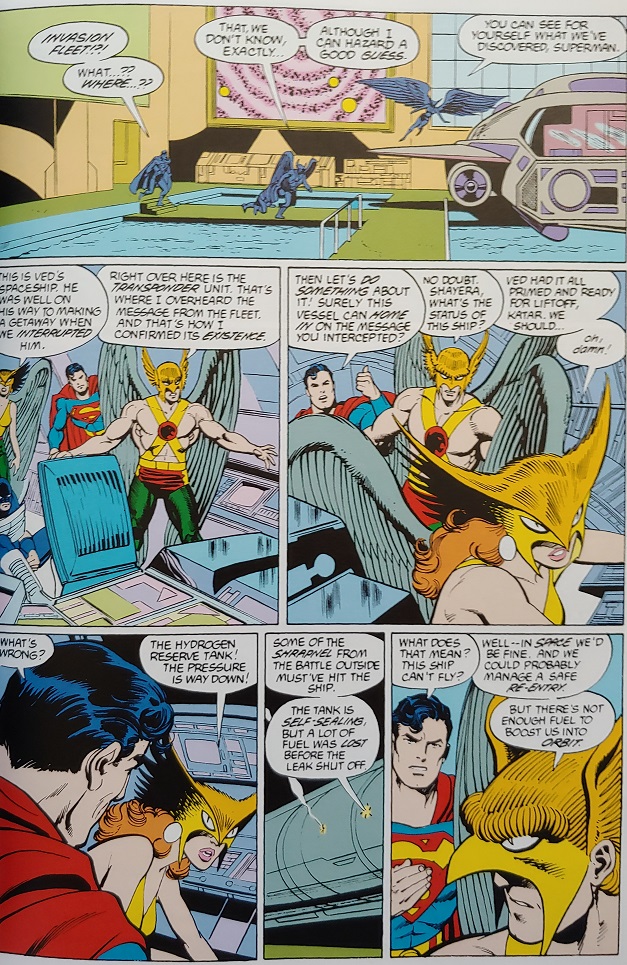Although in the 80s Action Comics was usually a stand-alone team up title in which Superman would interact with other DC superheroes, at some point John Byrne decided to give it a little bit of continuity. Action Comics # 588 ended with a cliffhanger as Hawkman and Hawkwoman are ambushed and Superman is left stranded in space. Although the Man of Steel is one of the most powerful heroes of the DC Universe, he can only survive in outer space for a couple of hours without a spacesuit.
In “Green on Green” (originally published in Action Comics # 589, June 1987), we find out what happens to Superman immediately after his adventure with Hawkman and Hawkwoman. With his reserves of oxygen depleted, Superman is agonizing until he is rescued by Arisia, a member of the Green Lantern Corps that finds him just in the nick of time. After recovering, the Man of Steel finds himself surrounded by Hal Jordan, at the time the most important Green Lantern of all, and a few other Green Lanterns from different planets, such as Kilowog, Salakk and Ch’p.
“In brightest day, in darkest night, no evil shall escape my sight. Let those who worship evil’s might beware my power… Green Lantern’s light” is the oath recited by Hal Jordan and the other Green Lanterns to charge their rings, together they have enough power to save entire planets, but they’re still happy to have someone like Superman helping them. And here, Byrne also connects the events of this story with the outcome of “And Graves Gave Up Their Dead” (Action Comics # 585).
“Better Dying Through Chemistry” (Action Comics # 590, July 1987), however, is a return to the typical independent episode, although it will have a sequel of sorts later on. This time the guest heroes are the Metal Men, androids created by Doctor Magnus, DC’s foremost specialist in robotics. Each one of the Metal Men has the special characteristics of a specific metal such as gold, tin, platinum, mercury, iron and lead.
 |
| Green Lantern (Hal Jordan) |
This issue has an interesting reference to Crisis on Infinite Earths, and I must say when I first read it so many years ago it was the first time I was made aware of such a pivotal saga. This time, the villain is Chemo, an artificial creature with chemical powers that, in contact with Kryptonian DNA, can temporarily mimic some of Superman’s traits. Both issues were written and penciled by Byrne, inked by Dick Giordano and colored by Tom Ziuco.
________________________________________________________________________________________________________
________________________________________________________________________________________________________
Aunque en los 80s, Action Comics solía ser un título de team-ups independiente en el que Superman interactuaba con otros superhéroes de DC, en algún momento John Byrne decidió darle un poco de continuidad. Action Comics # 588 terminó en suspenso cuando Hawkman y Hawkwoman son emboscados y Superman queda varado en el espacio. Aunque el Hombre de Acero es uno de los héroes más poderosos del Universo DC, sólo puede sobrevivir en el espacio exterior durante un par de horas sin un traje espacial.
 |
| Green Lantern Corps |
En “Verde sobre verde” (publicado originalmente en Action Comics # 589, junio de 1987), descubrimos lo que le sucede a Superman inmediatamente después de su aventura con Hawkman y Hawkwoman. Con sus reservas de oxígeno agotadas, Superman está agonizando hasta que es rescatado por Arisia, una integrante del Green Lantern Corps que lo encuentra justo a tiempo. Después de recuperarse, el Hombre de Acero se encuentra rodeado por Hal Jordan, en ese momento el Linterna Verde más importante de todos, y algunos otros Linternas Verdes de diferentes planetas, como Kilowog, Salakk y Ch'p.
 |
| Metal Men |
“En el día más brillante, en la noche más oscura, ningún mal escapará a mi vista. Que aquellos que adoran el mal teman mi poder... la luz de Green Lantern” es el juramento recitado por Hal Jordan y por los otros Green Lanterns para cargar sus anillos, juntos tienen suficiente poder para salvar planetas enteros, pero igual están contentos de tener a alguien como Superman ayudándolos. Y aquí, Byrne también conecta los eventos de esta historia con el desenlace de “And Graves Gave Up Their Dead” (Action Comics #585).
“Morir mejor a través de la química” (Action Comics # 590, julio de 1987), sin embargo, es un regreso al típico episodio independiente, aunque tendrá una especie de secuela más adelante. Esta vez los héroes invitados son los Metal Men, androides creados por el Doctor Magnus, el principal especialista en robótica de DC. Cada uno de los Hombres de Metal tiene las características especiales de un metal específico como el oro, el estaño, el platino, el mercurio, el hierro y el plomo.
 |
| Chemo |
Este número tiene una referencia interesante a Crisis en Tierras Infinitas, y debo decir que cuando lo leí por primera vez hace tantos años fue la primera vez que me acerqué a una saga tan fundamental. Esta vez, el villano es Chemo, una criatura artificial con poderes químicos que, en contacto con el ADN kryptoniano, puede imitar temporalmente algunos de los rasgos de Superman. Ambos números fueron escritos y dibujados a lápiz por Byrne, entintados por Dick Giordano y coloreados por Tom Ziuco.







































